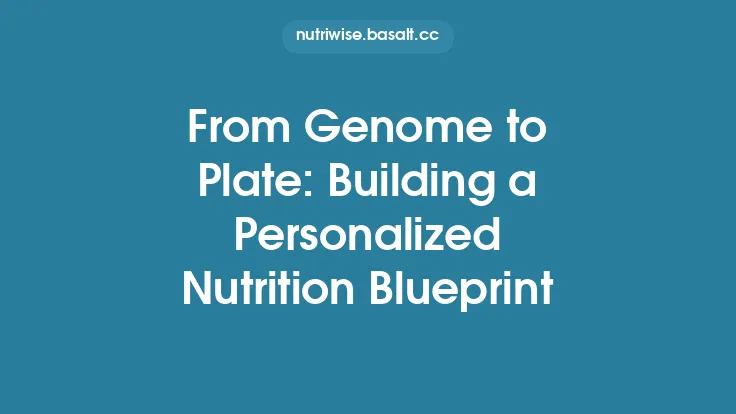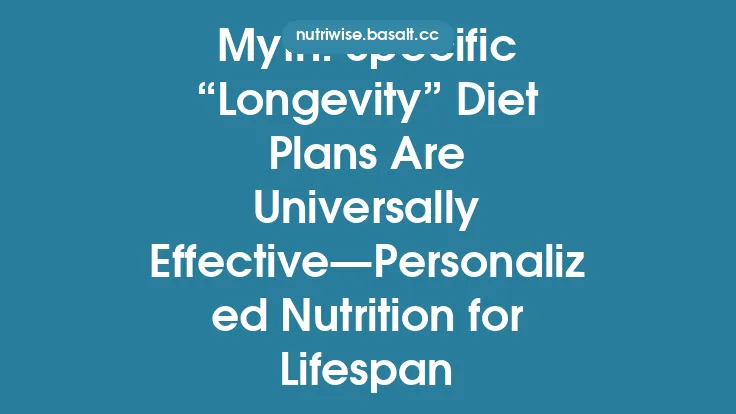Personalized nutrition sits at the intersection of genetics, biochemistry, and everyday food choices. While the science of nutrigenomics continues to evolve, many consumers now have access to genetic reports that promise to inform what they should eat. Translating those insights into a practical, day‑to‑day meal plan requires more than a simple “eat this because of that gene.” It demands a systematic approach that respects the complexity of human metabolism, acknowledges the limits of current knowledge, and integrates the genetic signal with lifestyle, cultural, and environmental context. The following guide walks through the essential concepts, workflow, and considerations for turning raw genetic data into a sustainable, personalized eating strategy.
Understanding the Core Genetic Markers Relevant to Nutrition
Genetic variation that influences nutrition can be grouped into several functional categories:
| Functional Category | Representative Genes | Typical Metabolic Impact |
|---|---|---|
| Lipid Metabolism | *APOE, LPL, FADS1/2* | Fatty acid synthesis, transport, and clearance; influences response to saturated vs. polyunsaturated fats |
| Carbohydrate Processing | *AMY1, SLC2A2* (GLUT2) | Salivary amylase production, glucose transport efficiency |
| Protein Utilization | *BCAT2, MUT* | Branched‑chain amino acid catabolism, vitamin B12-dependent pathways |
| Vitamin & Mineral Handling | *MTHFR, TCN2, SLC30A8* | Folate cycle efficiency, cobalamin transport, zinc homeostasis |
| Taste Perception & Appetite Regulation | *TAS2R38, FTO* (non‑coding regulatory region) | Bitter taste sensitivity, satiety signaling pathways |
These markers are the most consistently replicated in peer‑reviewed literature and form the backbone of most commercial nutrigenomic panels. Importantly, each gene typically exerts a modest effect size; the cumulative impact of multiple variants, together with non‑genetic factors, determines the overall phenotype.
From Genetic Report to Food Choices: A Step‑by‑Step Workflow
- Obtain a Certified Genetic Report
- Ensure the laboratory follows CLIA (Clinical Laboratory Improvement Amendments) standards or equivalent.
- Verify that the report includes raw genotype data (e.g., rsIDs) alongside interpreted phenotypes.
- Map Variants to Functional Pathways
- Use curated databases such as the Nutrient‑Gene Interaction Database (NGID) or the Human Gene Mutation Database (HGMD) to confirm the biological relevance of each variant.
- Prioritize variants with strong effect sizes (e.g., *APOE* ε4 allele) and those with actionable dietary guidance.
- Create a Personal Metabolic Profile
- Summarize the genotype‑derived traits (e.g., “Reduced conversion of ALA to EPA/DHA,” “Higher salivary amylase activity”).
- Assign a confidence level (high, moderate, low) based on the evidence base for each trait.
- Align Profile with Current Dietary Intake
- Conduct a brief food frequency questionnaire (FFQ) or 3‑day food diary.
- Identify mismatches between current intake and genetic predispositions (e.g., low omega‑3 intake in an individual with *FADS1* reduced desaturase activity).
- Define Target Adjustments
- For each high‑confidence trait, set a specific, measurable goal (e.g., “Increase EPA/DHA intake to 1.5 g/day”).
- Use evidence‑based ranges from dietary reference intakes (DRIs) and clinical guidelines as anchors.
- Develop a Meal Planning Template
- Choose a flexible framework (e.g., “plate method,” “macro‑balanced meals”) that can accommodate the target adjustments.
- Populate the template with food groups that naturally meet the genetic recommendations (e.g., fatty fish for *FADS variants, whole grains for AMY1* high‑amylase carriers).
- Iterate and Refine
- After 4–6 weeks, reassess dietary adherence, biochemical markers (if available), and subjective outcomes (energy, satiety).
- Adjust the plan based on observed response and any new scientific updates.
Designing Balanced Meals Aligned with Your Genotype
A practical meal plan does not require exotic ingredients; it simply emphasizes foods that complement the individual’s metabolic tendencies.
| Genetic Insight | Food Strategy | Example Meal Components |
|---|---|---|
| Reduced conversion of plant‑based omega‑3s (*FADS1/2* low‑activity alleles) | Prioritize pre‑formed long‑chain EPA/DHA | Wild‑caught salmon, sardines, algae‑derived oil capsules |
| High salivary amylase activity (*AMY1* copy‑number gain) | Favor complex carbohydrates with lower glycemic spikes | Steel‑cut oats, quinoa, legumes |
| Impaired folate cycle (*MTHFR* C677T TT genotype) | Ensure adequate methyl‑folate and supporting B‑vitamins | Dark leafy greens, fortified cereals, riboflavin‑rich dairy |
| Altered lipid transport (*APOE* ε4) | Emphasize monounsaturated fats, limit saturated fats | Extra‑virgin olive oil, avocado, nuts |
| Reduced branched‑chain amino acid catabolism (*BCAT2* variants) | Moderate intake of high‑BCAA foods, balance with plant proteins | Lean poultry, tofu, lentils |
Meal Construction Tips
- Macro Distribution: Aim for a baseline of 45–55 % carbohydrates, 20–30 % protein, and 25–35 % fats, then tweak each macro according to the genotype‑derived goals.
- Food Pairing: Combine foods that enhance nutrient bioavailability (e.g., vitamin C‑rich fruits with iron‑rich legumes to improve non‑heme iron absorption).
- Portion Control: Use visual cues (hand‑size portions) to maintain energy balance while focusing on quality rather than strict calorie counting.
- Cultural Fit: Substitute culturally familiar foods that provide the same nutrient profile (e.g., replace salmon with mackerel in regions where the latter is more accessible).
Incorporating Lifestyle and Environmental Factors
Genetic predispositions are only one piece of the puzzle. A robust personalized plan also accounts for:
- Physical Activity Level – Exercise modulates lipid oxidation, insulin sensitivity, and protein turnover, potentially offsetting or amplifying genetic effects.
- Age and Hormonal Status – Metabolic pathways shift across the lifespan; for instance, post‑menopausal women may require higher omega‑3 intake regardless of *FADS* status.
- Geographic Food Availability – Seasonal and regional food supply can dictate which genotype‑aligned foods are realistic.
- Medication Interactions – Certain drugs (e.g., statins) intersect with lipid metabolism genes, influencing dietary recommendations.
By overlaying these variables onto the genetic framework, the resulting meal plan becomes truly individualized rather than a static list of “do this because of that SNP.”
Tools and Resources for Ongoing Meal Planning
| Resource Type | Example | How It Supports Personalization |
|---|---|---|
| Digital Meal‑Planning Platforms | EatLove, Nutrigenomix Planner (clinical version) | Allow users to input genotype traits and generate weekly menus with grocery lists. |
| Nutrient Databases | USDA FoodData Central, EuroFIR | Provide detailed macro‑ and micronutrient breakdowns for precise food selection. |
| Mobile Tracking Apps | MyFitnessPal (custom nutrient goals), Cronometer (micronutrient focus) | Enable real‑time monitoring of intake against genotype‑derived targets. |
| Professional Consultation | Registered dietitian with nutrigenomics certification | Offers nuanced interpretation, especially for complex or low‑confidence variants. |
| Scientific Literature Alerts | PubMed RSS feeds for “nutrigenomics” + “dietary intervention” | Keeps the user informed about emerging evidence that may refine recommendations. |
When selecting tools, prioritize those that are transparent about their algorithms, allow manual adjustments, and respect data privacy (e.g., GDPR compliance, encrypted storage).
Interpreting Results: Common Pitfalls and How to Avoid Them
- Over‑emphasis on Single Variants
- *Pitfall: Treating one SNP as a deterministic rule (e.g., “I must avoid all dairy because of a LCT* variant”).
- *Solution*: Evaluate the cumulative genotype profile and consider the magnitude of effect; many traits are polygenic.
- Confusing Correlation with Causation
- *Pitfall*: Assuming that an association observed in a cohort automatically applies to the individual.
- *Solution*: Look for replication across multiple studies and, when possible, functional validation (e.g., enzyme activity assays).
- Neglecting Gene‑Environment Interactions
- *Pitfall*: Ignoring that lifestyle can mitigate or exacerbate genetic risk.
- *Solution*: Integrate physical activity, sleep, stress, and environmental exposures into the planning process.
- Relying on Outdated Databases
- *Pitfall*: Using nutrigenomic interpretations that predate recent genome‑wide association studies (GWAS).
- *Solution*: Verify that the interpretation source cites literature from the past five years.
- Assuming Immediate Clinical Outcomes
- *Pitfall*: Expecting rapid changes in biomarkers or health status.
- *Solution*: Set realistic timelines (3–6 months) and monitor incremental improvements.
Ethical, Privacy, and Practical Considerations
- Informed Consent – Before ordering a test, understand what data will be stored, who can access it, and the intended use.
- Data Ownership – Choose providers that grant you full rights to download raw genotype files.
- Potential for Discrimination – Be aware of legal protections (e.g., GINA in the United States) but also recognize gaps in coverage for life or disability insurance.
- Cost‑Benefit Analysis – Genetic testing can be expensive; weigh the incremental value of personalized recommendations against standard evidence‑based dietary guidelines.
- Professional Oversight – Nutrigenomic information should complement, not replace, advice from qualified health professionals, especially for individuals with chronic conditions.
Future Directions in Translating Genetic Data to Everyday Diets
The field is moving toward more integrative models that combine genomics with other “omics” layers:
- Transcriptomics & Metabolomics – Real‑time snapshots of gene expression and metabolite flux can refine dietary recommendations beyond static DNA.
- Polygenic Risk Scores (PRS) – Aggregating thousands of variants into a single score may predict broader dietary responsiveness (e.g., overall lipid profile changes).
- Artificial Intelligence‑Driven Meal Engines – Machine‑learning algorithms can dynamically adjust meal plans as new data (e.g., continuous glucose monitoring) become available.
- Microbiome‑Genotype Interactions – While distinct from gut‑health‑focused articles, emerging research suggests that host genetics can shape microbial composition, which in turn influences nutrient metabolism.
As these technologies mature, the translation pipeline—from raw genetic insight to a concrete grocery list—will become faster, more precise, and increasingly personalized. Until then, a disciplined, evidence‑grounded approach that respects both the power and the limits of genetic information remains the most reliable path to everyday meal planning success.





